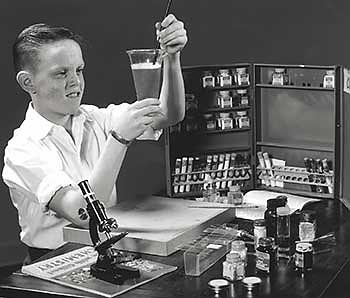There was a time in the not-too-distant past when America was a leader in the field of science. Advances in theoretical physics, nuclear technology and space exploration in the mid-1900s offered an optimistic view of the future and produced an interest in science among children across the nation.
As a result, brands like Gilbert and Chemcraft produced exciting and surreptitiously educational chemistry sets loaded with beakers, Bunsen burners and dozens of chemicals. And if you were anything like me, you'll remember tossing aside the experiment booklet and randomly mixing things together until something exploded and left a permanent blue stain on the ceiling. That, my friends, was education.
Unfortunately, those days are long gone. Anyone who owns the types of chemicals once sold as a fun, "career-building science set" ends up on an FBI watch list as either a potential terrorist or the possible owner of a meth lab. Hell, some states have even started requiring permits to own something as innocuous as an Erlenmeyer flask. As a result, the chemistry sets sold today are pathetic imitations of those from the past, offering cheap, plastic instruments and little more than soda ash and some litmus paper.
Still, there's hope. If you're pining for those days of juvenile experimentation, or you'd like to give your child the same experience you had as a kid, Make has just published a guide to creating your own homemade chemistry set. They offer a list of substances you'll probably be interested in, along with legitimate sources where you can get them — even radioactive materials!
What better DIY holiday gift could there be?




